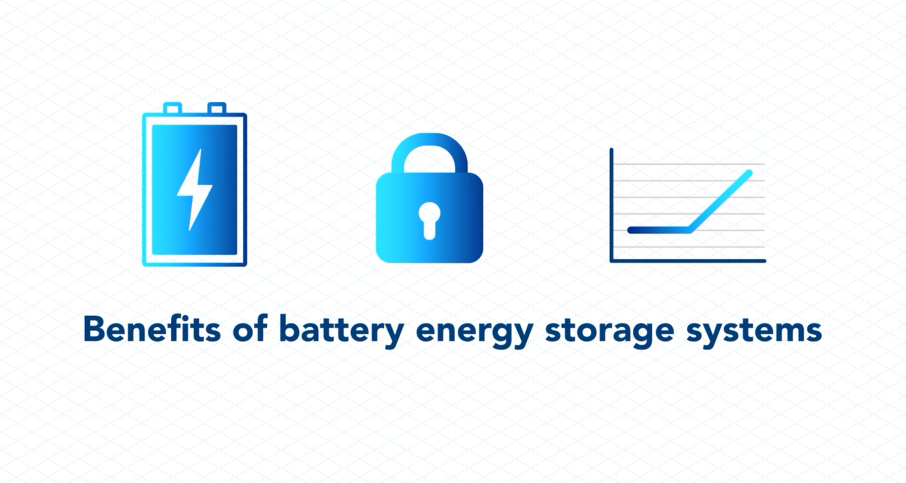Learn More About Battery Storage
Tenaska aims to be a good steward of the land and the communities where we develop battery storage projects.
-
10 States
Of battery storage development experience
-
8,200 MW
Of battery storage development footprint
-
35 Years
Of Tenaska energy development experience
Benefits of Battery Storage
Demand for battery storage continues to grow from utilities and larger power users. We work with landowners to develop battery storage projects where there is nearby access to a substation and a community that is supportive of its economic benefits.
Battery storage sites host banks of batteries connected to the electric grid. Batteries can capture excess generation during periods of low demand, particularly when that coincides with times of peak generation from wind or solar. Batteries can store this unused energy and then discharge it back to the grid, often in the evening or at other peak times, providing grid resiliency and reliability.

Why battery storage?
Battery energy storage systems improve our electric grid, increase energy security for our local homes and businesses and create new tax revenue for local schools and services. Learn more about the benefits of battery storage and how it can help support our aging power grid.
Phases of a
Battery Storage Facility
-
Pre-development
2-3 MONTHS
An interconnection request is filed with a grid operator, beginning a multi-year process to deliver power to the end users.
Tenaska begins to contact preferred landowners.
-
Development
2-3 Years
Various engineering and environmental studies are performed, and participating landowners are notified in advance of any study work on their land. These studies analyze migration patterns, local geology, soil characteristics, wetlands and wildlife habitats to ensure facility placement is as safe, minimally invasive and efficient as possible.
The project applies for applicable state and federal permits that govern wildlife and waterways and seeks appropriate approvals from state and local governments.
Tenaska secures a customer for the power to help assure the overall economic viability of the project.
Near the end of this phase, we exercise the option agreements with landowners to position the project for construction. This starts the lease period.
-
Construction
1 Year
An engineering, procurement and construction contractor is hired to place the battery units and connect them to the transmission system. We aim to source qualified, local labor and local materials as much as possible.
-
Operation
30 Years
The battery storage facility is maintained for up to 30 years by a full-time operations team, which is typically 1-3 people.
-
Decommissioning
After the contract period ends, we remove the battery facility and access roads, and any damages are repaired so that the land may be used for other purposes.
-
Provides Stable Income
Local landowners and their families are supported by consistent lease payments.
-
Ensures Profit
Any costs resulting from construction, operation or increased property taxes are paid for by the company.
-
Supports the Local Economy
Battery storage projects can boost tax revenue for community improvements, create job opportunities for qualified, local construction workers and suppliers, and increase business at local establishments.
-
Assists Energy Independence
Battery storage facilities strengthen the local electrical grid and increase its reliability to help prevent rolling brownouts.
Keeping Battery Storage Safe
Learn more about how battery energy storage systems are set up and operated. Safety is the top priority of the system’s design. Purpose-built enclosures, improved battery chemistries and input from first responders and third-party industry safety professionals keep our facilities safe.
We Encourage You to Ask Questions
What is a battery energy storage system (BESS)?
Utility-scale, battery energy storage systems are large banks of batteries connected to the electric grid. Battery energy storage systems add greater reliability and resilience to the electrical grid. During times of peak energy generation, such as when power from solar or wind is in abundance, batteries can be charged to capture excess generation. Batteries can then discharge this stored generation into the grid during times of peak energy demand.
How do battery energy storage systems work?
A battery energy storage system (BESS) facility is designed to store power from the power grid (charge) when there is an excess of power being produced and release power back to the power grid (discharge) when there is a shortage of power being produced.
What are the benefits of hosting this BESS in our community?
Battery energy storage systems provide many benefits to the community:
- Improved electric reliability for local homes and businesses with no pollution.
- Added tax revenue for local government and new construction jobs with no increase in traffic or new demand for public services.
- Improved public health by reducing air pollution, which benefits all customers but especially highly impacted communities and populations that are disproportionately affected by air pollution.
How does a BESS help our electric grid become more stable and modern?
Battery energy storage systems help our grid in many ways:
- Help utilities manage the cost of electricity by storing excess energy until it is needed and delivering power more quickly and efficiently than traditional generators.
- Ensure that the grid can quickly meet rapid spikes in demand, reducing the chances of blackouts or brownouts.
- Reduce the reliance on expensive, inefficient fossil-fueled peaking plants to meet increases in demand for power.
Committed to Hard Work and Honest Dealing
Over the past 35 years, Tenaska has earned a reputation for developing responsible energy projects and being a good business neighbor. We have developed, managed and/or operated approximately 22,000 megawatts of generating facilities.


